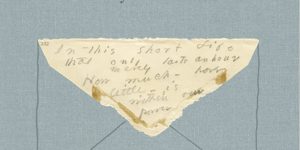15 Reads
Autumn/Winter 2021
Selected and described by Jane McArthur with a contribution each
from Briony Anderson and Tina Fiske
the lives of things
construction, structure
repurposing
work
place
In the spotlight

Mary Norton
The Borrowers
For younger Readers
Mary Norton, The Borrowers, (1952), Puffin, 1993
Listen to an excerpt
Beneath the kitchen floorboards the Borrowers have made their miniature home, created from adapted odds and ends ‘borrowed’ from the humans in whose house they live. Pod makes regular forays up into the house with his borrowing bag returning to his wife Homily and daughter Arietty with food and furnishings which sustain their secret existence, until Arietty who longs for freedom and the company of her own kind persuades Pod to let her join him. Out in the wider world, Arietty strikes up an acquaintance which for a time heralds a golden age of borrowing but may ultimately threaten the family’s very existence.

Leanne Shapton
Important Artifacts...
Leanne Shapton, Important Artifacts and Personal Property from the Collection of Lenore Doolan and Harold Morris: Including Books, Street Fashion and Jewellery, Bloomsbury, 2009.
Listen to an excerpt
Assemblage meets narrative in the story of the interests of and relationship between Lenore and Harold. Adopting the format and language of an auction catalogue, this intriguing fictional account places the objects belonging to, and exchanged between the couple, as witnesses, divulging clues to the three-year arc of their time together. Random things each gathered: gifts to each other, notes, invitations, photographs and the items that made up their everyday lives are listed on the pages, the numbered descriptions devoid of sentiment, leaving the reader to piece together the emotions and events of Leonore and Harold’s time together.

Stephen Connor
Paraphernalia
Stephen Connor, Paraphernalia: The Curious Lives of Magical Things, Profile Books, 2013.
Listen to an excerpt
Pins, buttons, combs, keys, rubber bands – the overlooked, easily lost, semi-disposable ephemera take centre place in Connor’s investigation of the marginalia of the everyday. The embodied lives of things are considered through the lens of history, etymology, philosophy, contemporary culture, folklore and Connor’s own personal relationship with each object. Even in the digitised world where the thingness of objects has been transmuted to a command or a graphic, they are still, he shows, connected to us and we to them. These objects, concrete and digital, ‘bear our signatures, have our lives in their charge, and may one day amount to what we were.’

Georges Perec
I Remember
Georges Perec, I Remember, (1979), introduced and translated by Philip Terry and David Bellos, Gallic Books, 2014.
Listen to an excerpt
I Remember … is structured in 479 numbered sentences, each beginning with these two words. Juxtaposed fragments form a matrix of intersecting memories of moments in popular culture and politics, also including jokes, song lyrics and wordplay. Each recollection is the often overlooked, seemingly ephemeral instance of the everyday which build as the text develops into a multi-faceted experience of a particular time and place, whilst affording glimpses of Perec himself. True to the Oulipo spirit, following the subverted index (or non-index, for it does not function as a formal index), Perec left blank pages for the reader to fill with their own I Remember … which of course is easier said than done, for Perec’s seemingly simple structure is minutely crafted.
The Borrowers (Mary Norton)
Important Artifacts and Personal Property from the Collection of Lenore Doolan and Harold Morris: Including Books, Street Fashion and Jewellery. (Leanne Shapton)
Paraphernalia: The Curious Lives of Magical Things (Stephen Connor)
I Remember (Georges Perec)
Featuring

Mary Chamberlain
Fen Women
Mary Chamberlain, Fen Women: A Portrait of Women in an English Village, (1975), Full Circle Editions, 2011.
Recognising that women’s stories had until that time been subsumed in an essentially masculine viewpoint of history whilst the female experiences of the working and rural poor had been ignored, Chamberlain set out to address this, giving voice to women living in the Cambridgeshire fens. They describe their working and social lives, their enjoyments, sufferings, frustrations and ambitions; their memories spanning a century of lived and inherited experience. Revisiting the village thirty-five years later, Chamberlain recorded changes both in the village and in the lives of those she had previously met.

N. Scott Momaday
House Made of Dawn
N.Scott Momaday, House Made of Dawn (1966), Harper Perennial, 2010.
The young Native American Abel returns home from the war and tries to re-find a place in the established practices and rituals of his community, but circumstances interject and he is forced into exile. Subsumed by the discriminating Anglo-American city culture, Abel only finally returns to the land of his Kiowa forebears following serious injury. Shaped by traditional storytelling, Momaday’s modernist prose examines the bonds between people and place, the things they live with, the traditions they live by and what arises when those bonds are destroyed. For Abel however there is redemption, when like his grandfather before him, he takes his place in the dawn run.

Toni Morrison
Jazz
Toni Morrisson, Jazz, Chatto & Windus, 1992.
Language riffs with the tempo of the city, moderated with blues notes and moments of sweet lyricsm offset by discordancy. A phrase returned to is embellished and improvised upon before the rhythm is picked up again and moves on, telling the story of Violet and Joe and the murdered girl Joe loved too much, speaking the experiences that inspired New York Jazz in the 1920s. Each character achieves their moment in the limelight, relaying a part of their story before the pace moves on, shifting, offering other perspectives of life either in the rural south sunk in the recent experience of slavery, or hustling in the urban streets, seeking escape from the past only to be confronted once again by its realities.

John Berger
Photocopies
John Berger, Photocopies, Bloomsbury, 1997
In this series of personal recollections, Berger seeks to recall particular moments in time that he has shared with people he has known, conjuring if you like, a ‘verbal photocopy’. The reader meets people who are known and close to Berger, as well as those whom he has met in chance encounters. The place of each encounter plays a powerful role in portraying each individual and the nature of his relationship to them. Each title of the 29 ‘photocopies’ gives an objective description of the place or the person: ‘A Young Woman Wearing a Chapka’, ‘A Man Begging in the Metro’, ‘Young Woman with Hand to her Chin’ – all of which capture the connections we all make and carry with us, retaining the ‘photocopies’ in our minds.

Sembene Ousmane
God's Bits of Wood
Sembene Ousmane, God’s Bits of Wood, translated by Francis Price, (1960), Heineman African Writer’s Series, 1995.
This is a story of the 1947–8 strike by the Dakar-Niger railway workers who laid down their tools and resisted the French colonial system. This is a story of their courage, determination against the odds, endurance, community, love, suffering and deprivation. This is a story of a man with vision and of the women who march on the city of Dakar when it seems that the strike will fail. Rendered in all its complexity, Ousmane neither romanticises nor sensationalises this important moment in history.

Deepak Unnikrishnan
Temporary People
Deepak Unnikrishnan, Temporary People, Restless Books, 2017.
A man metamorphoses into a suitcase and attempts to board a plane; ideal workers with a twelve-year lifespan are grown in a lab; a woman stitches construction workers back together; a rebel community amasses in the desert. The content of the book’s twenty-eight linked stories is raw, sometimes surreal, often brutal, where narrative occasionally shifts into the realms of dystopia emphasising the already fractured lines of the dehumanised and dehumanising global trade in itinerant immigrant workers.

Emily Dickinson
Envelope Poems
Emily Dickinson, Envelope Poems, with transcriptions by Marta L. Werner and Jen Bevin, Christine Burgin / New Directions, 2016
The handmade and the repurposed played a particular role in the writing of Emily Dickinson. She published relatively few of her poems through conventional means, instead gathering the large extent of her output into handmade packages, or ‘fascicles’ as they were later referred to. In her later years, Dickinson would write on small scraps of found paper – very often torn pieces of envelope – her words in pencil following along a fold or gum line or alongside other handwriting. The resulting so-called ‘envelope poems’ are themselves fragmentary and elusive in nature – like phrases or thoughts captured that might be found and saved.

Jenny Erpenbeck
Visitation

Lyn Hejinian
Oxota: A Short Russian Novel
Lyn Hejinian, Oxota: A Short Russian Novel, Wesleyan University Press, 2019.
Listen to an excerpt
A reflection of a time: the last years of the Cold War; a place, Leningrad; and the friendship between Hejinian and the poet Arkadii Dragomoshchenko—each chapter a fourteen-line poem after Alexander Pushkin’s Eugene Onegin. Two worlds, each exposing the other, the recounted situations at once surreal, everyday, ominous, de-stabilising and homely, where every word is critical, and how each is employed a matter of survival in the totalitarian state of the USSR. Exploring the possibilities of language, Hejinian shows the reader the absolute importance of context and how the careful choice and placement of one word with another occasions subtexts to emerge from the shadows.

Clarice Lispecter
Agua Viva
Clarice Lispecter, Agua Viva, (1973), translated by Stefan Tober, Introduced and Edited by Benjamin Moser, Penguin, 2014.
Listen to an excerpt
Re-assembled from two of her unpublished short stories, Loud Objects and Beyond Thought, Lispecter in the guise of the painter-narrator, takes the reader deep into her writing process, so deep, that with her you reach the point where language seems to fail, where language looses its specificity, pointing to a place beyond itself, leaving author and the reader exposed in a no-time of pure experience. Events arise and dissolve, character and narrative are cut away in this brave, unique slim volume of pure originality and profound thought-experience.

Magdalena Tulli
Moving Parts
Magdalena Tulli, Moving Parts, (2003), translated by Bill Johnston, Archipelago Books, 2005.
Listen to an excerpt
How can history be committed to paper? Surely there is more to a life than the picture of history often created? How can the lives and losses, betrayals and violences of the last century be expressed in a story line, in clauses and words fixed in sentences? How does the narrator direct the lives of his characters – a jazz trumpeter, a red headed woman, a tightrope walker, a Polish publisher – and the things that surround them, when each continuously subverts what should have been a simple plot? The only possible response for the long-suffering narrator is to dismantle what he has constructed and begin again from another viewpoint until yet again histories break through disrupting the narrative. And what of the man in overalls with the photograph of the girl in his wallet?
